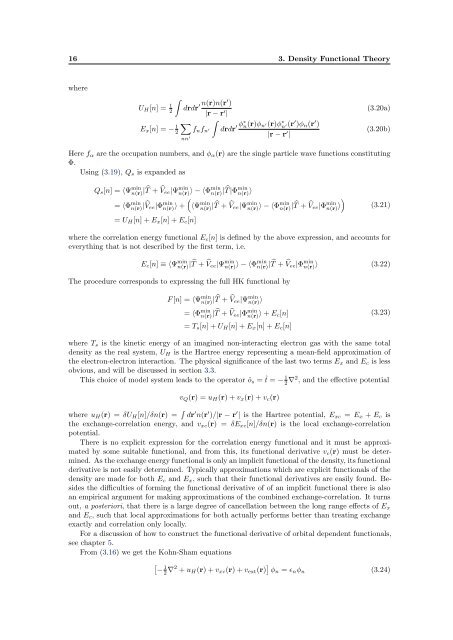Exact Exchange in Density Functional Calculations
Exact Exchange in Density Functional Calculations
Exact Exchange in Density Functional Calculations
You also want an ePaper? Increase the reach of your titles
YUMPU automatically turns print PDFs into web optimized ePapers that Google loves.
16 3. <strong>Density</strong> <strong>Functional</strong> Theorywhere∫U H [n] = 1 2drdr ′ n(r)n(r′ )|r − r ′ |∑∫E x [n] = − 1 2f n f n ′ drdr ′ φ∗ n(r)φ n ′(r)φ ∗ n ′(r′ )φ n (r ′ )|r − r ′ |nn ′(3.20a)(3.20b)Here f α are the occupation numbers, and φ α (r) are the s<strong>in</strong>gle particle wave functions constitut<strong>in</strong>gΦ.Us<strong>in</strong>g (3.19), Q s is expanded asQ s [n] = 〈Ψ m<strong>in</strong>n(r) | ̂T + ̂V ee |Ψ m<strong>in</strong>n(r) 〉 − 〈Φm<strong>in</strong> n(r) | ̂T |Φ m<strong>in</strong>n(r)(〉= 〈Φ m<strong>in</strong>n(r) |̂V ee |Φ m<strong>in</strong>n(r) 〉 + 〈Ψ m<strong>in</strong>n(r) | ̂T + ̂V ee |Ψ m<strong>in</strong>n(r) 〉 − 〈Φm<strong>in</strong> n(r) | ̂T + ̂V)ee |Φ m<strong>in</strong>n(r) 〉= U H [n] + E x [n] + E c [n](3.21)where the correlation energy functional E c [n] is def<strong>in</strong>ed by the above expression, and accounts foreveryth<strong>in</strong>g that is not described by the first term, i.e.E c [n] ≡ 〈Ψ m<strong>in</strong>n(r) | ̂T + ̂V ee |Ψ m<strong>in</strong>n(r) 〉 − 〈Φm<strong>in</strong> n(r) | ̂T + ̂V ee |Φ m<strong>in</strong>n(r) 〉 (3.22)The procedure corresponds to express<strong>in</strong>g the full HK functional byF [n] = 〈Ψ m<strong>in</strong>n(r) | ̂T + ̂V ee |Ψ m<strong>in</strong>n(r) 〉= 〈Φ m<strong>in</strong>n(r) | ̂T + ̂V ee |Φ m<strong>in</strong>n(r) 〉 + E c[n]= T s [n] + U H [n] + E x [n] + E c [n](3.23)where T s is the k<strong>in</strong>etic energy of an imag<strong>in</strong>ed non-<strong>in</strong>teract<strong>in</strong>g electron gas with the same totaldensity as the real system, U H is the Hartree energy represent<strong>in</strong>g a mean-field approximation ofthe electron-electron <strong>in</strong>teraction. The physical significance of the last two terms E x and E c is lessobvious, and will be discussed <strong>in</strong> section 3.3.This choice of model system leads to the operator ô s = ˆt = − 1 2 ∇2 , and the effective potentialv Q (r) = u H (r) + v x (r) + v c (r)where u H (r) = δU H [n]/δn(r) = ∫ dr ′ n(r ′ )/|r − r ′ | is the Hartree potential, E xc = E x + E c isthe exchange-correlation energy, and v xc (r) = δE xc [n]/δn(r) is the local exchange-correlationpotential.There is no explicit expression for the correlation energy functional and it must be approximatedby some suitable functional, and from this, its functional derivative v c (r) must be determ<strong>in</strong>ed.As the exchange energy functional is only an implicit functional of the density, its functionalderivative is not easily determ<strong>in</strong>ed. Typically approximations which are explicit functionals of thedensity are made for both E c and E x , such that their functional derivatives are easily found. Besidesthe difficulties of form<strong>in</strong>g the functional derivative of of an implicit functional there is alsoan empirical argument for mak<strong>in</strong>g approximations of the comb<strong>in</strong>ed exchange-correlation. It turnsout, a posteriori, that there is a large degree of cancellation between the long range effects of E xand E c , such that local approximations for both actually performs better than treat<strong>in</strong>g exchangeexactly and correlation only locally.For a discussion of how to construct the functional derivative of orbital dependent functionals,see chapter 5.From (3.16) we get the Kohn-Sham equations[−12 ∇2 + u H (r) + v xc (r) + v ext (r) ] φ n = ɛ n φ n (3.24)












